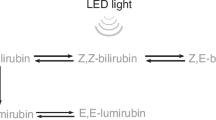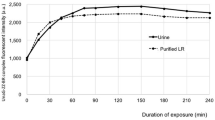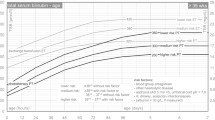Abstract
Background:
Phototherapy using blue light is the treatment of choice worldwide for neonatal hyperbilirubinemia. However, treatment with turquoise light may be a desirable alternative. Therefore, the aim of this randomized, controlled study was to compare the bilirubin isomer distribution in serum of jaundiced neonates after 24 h of therapy with narrow-band (LED) light centered at 497 nm (turquoise) vs. 459 nm (blue), of essentially equal irradiance.
Materials:
Eighty-three neonates (≥33 wk gestational age) with uncomplicated hyperbilirubinemia were included in the study. Forty neonates were exposed to light centered at 497 nm and 43 infants with light centered at 459 nm. Irradiances were 5.2 × 1015 and 5.1 × 1015 photons/cm2/s, respectively.
Results:
After 24 h of treatment no significant differences in serum concentrations of total bilirubin isomers and Z,Z-bilirubin were observed between the 2 groups. Interestingly, concentrations of Z,E-bilirubin, and thus also total bilirubin isomers formed during therapy, were highest for infants receiving light centered at 459 nm, while the concentration of E,Z-bilirubin was highest for those receiving light centered at 497 nm. No significant difference was found between concentrations of E,Z-lumirubin.
Conclusion:
Therapy with LED light centered at 497 nm vs. 459 nm, applied with equal irradiance on the infants, resulted in a different distribution of bilirubin isomers in serum.
Similar content being viewed by others
Log in or create a free account to read this content
Gain free access to this article, as well as selected content from this journal and more on nature.com
or
References
Bhutani VK, Zipursky A, Blencowe H, et al. Neonatal hyperbilirubinemia and Rhesus disease of the newborn: incidence and impairment estimates for 2010 at regional and global levels. Pediatr Res 2013;74 Suppl 1:86–100.
Maisels MJ, McDonagh AF. Phototherapy for neonatal jaundice. N Engl J Med 2008;358:920–8.
McDonagh AF. Controversies in bilirubin biochemistry and their clinical relevance. Semin Fetal Neonatal Med 2010;15:141–7.
McDonagh AF, Agati G, Fusi F, Pratesi R. Quantum yields for laser photocyclization of bilirubin in the presence of human serum albumin. Dependence of quantum yield on excitation wavelength. Photochem Photobiol 1989;50:305–19.
Onishi S, Itoh S, Isobe K. Wavelength-dependence of the relative rate constants for the main geometric and structural photoisomerization of bilirubin IX alpha bound to human serum albumin. Demonstration of green light at 510 nm as the most effective wavelength in photochemical changes from (ZZ)-bilirubin IX alpha to (EZ)-cyclobilirubin IX alpha via (EZ)-bilirubin. Biochem J 1986;236:23–9.
Lightner DA, Linnane WP 3rd, Ahlfors CE. Bilirubin photooxidation products in the urine of jaundiced neonates receiving phototherapy. Pediatr Res 1984;18:696–700.
American Academy of Pediatrics. Management of hyperbilirubinemia in the newborn infant 35 or more weeks of gestation. Pediatr 2004;114:297–316.
Agati G, Fusi F, Donzelli GP, Pratesi R. Quantum yield and skin filtering effects on the formation rate of lumirubin. J Photochem Photobiol B 1993;18:197–203.
Lamola AA, Bhutani VK, Wong RJ, Stevenson DK, McDonagh AF. The effect of hematocrit on the efficacy of phototherapy for neonatal jaundice. Pediatr Res 2013;74:54–60.
Ebbesen F, Madsen P, Støvring S, Hundborg H, Agati G. Therapeutic effect of turquoise versus blue light with equal irradiance in preterm infants with jaundice. Acta Paediatr 2007;96:837–41.
Ebbesen F, Vandborg PK, Madsen PH, Trydal T, Jakobsen LH, Vreman HJ. Effect of phototherapy with turquoise vs. blue LED light of equal irradiance in jaundiced neonates. Pediatr Res 2016;79:308–12.
Ennever JF, Knox I, Denne SC, Speck WT. Phototherapy for neonatal jaundice: in vivo clearance of bilirubin photoproducts. Pediatr Res 1985;19:205–8.
Mreihil K, Madsen P, Nakstad B, Benth JŠ, Ebbesen F, Hansen TW. Early formation of bilirubin isomers during phototherapy for neonatal jaundice: effects of single vs. double fluorescent lamps vs. photodiodes. Pediatr Res 2015;78:56–62.
Agati G, Fusi F, Pratesi S, Galvan P, Donzelli GP. Bilirubin photoisomerization products in serum and urine from a Crigler-Najjar type I patient treated by phototherapy. J Photochem Photobiol B 1998;47:181–9.
Costarino AT, Ennever JF, Baumgart S, Speck WT, Paul M, Polin RA. Bilirubin photoisomerization in premature neonates under low- and high-dose phototherapy. Pediatr 1985;75:519–22.
Itoh S, Onishi S, Isobe K, Manabe M, Yamakawa T. Wavelength dependence of the geometric and structural photoisomerization of bilirubin bound to human serum albumin. Biol Neonate 1987;51:10–7.
Saunders NR, Liddelow SA, Dziegielewska KM. Barrier mechanisms in the developing brain. Front Pharmacol 2012;3:1–18.
Ruud Hansen TW. Phototherapy for neonatal jaundice–therapeutic effects on more than one level? Semin Perinatol 2010;34:231–4.
Jasprova J, Dal Ben M, Vianello E, et al. The biological effects of bilirubin photoisomers. PLoS One 2016;11:e0148126.
Cashore WJ, Oh W. Unbound bilirubin and kernicterus in low-birth-weight infants. Pediatr 1982;69:481–5.
Onishi S, Isobe K, Itoh S, et al. Metabolism of bilirubin and its photoisomers in newborn infants during phototherapy. J Biochem 1986;100:789–95.
Pearce N, Checkoway H, Kriebel D. Bias in occupational epidemiology studies. Occup Environ Med 2007;64:562–8.
Itoh S, Isobe K, Onishi S. Accurate and sensitive high-performance liquid chromatographic method for geometrical and structural photoisomers of bilirubin IX alpha using the relative molar absorptivity values. J Chromatogr A 1999;848:169–77.
Doumas BT, Kwok-Cheung PP, Perry BW, et al. Candidate reference method for determination of total bilirubin in serum: development and validation. Clin Chem 1985;31:1779–89.
Acknowledgements
We thank Stephanie Kourula, PhD and Benjamin K. Cline, MS for technical assistance and valuable discussions. Ronald J. Wong, BA, is thanked for critical review of the manuscript. We are grateful to Rami Vardi of Bright Light LED, (Canoga Park, CA) for technical support and donation of the LED tubes and driver.
Author information
Authors and Affiliations
Corresponding author
PowerPoint slides
Rights and permissions
About this article
Cite this article
Ebbesen, F., Madsen, P., Vandborg, P. et al. Bilirubin isomer distribution in jaundiced neonates during phototherapy with LED light centered at 497 nm (turquoise) vs. 459 nm (blue). Pediatr Res 80, 511–515 (2016). https://doi.org/10.1038/pr.2016.115
Received:
Accepted:
Published:
Issue date:
DOI: https://doi.org/10.1038/pr.2016.115
This article is cited by
-
Urinary lumirubin excretion in jaundiced preterm neonates during phototherapy with blue light-emitting diode vs. green fluorescent lamp
Scientific Reports (2023)
-
Characteristics of bilirubin photochemical changes under green light-emitting diodes in humans compared with animal species
Scientific Reports (2021)
-
Sixty years of phototherapy for neonatal jaundice – from serendipitous observation to standardized treatment and rescue for millions
Journal of Perinatology (2020)
-
A novel accurate LC-MS/MS method for quantitative determination of Z-lumirubin
Scientific Reports (2020)
-
The effect of light wavelength on in vitro bilirubin photodegradation and photoisomer production
Pediatric Research (2019)



